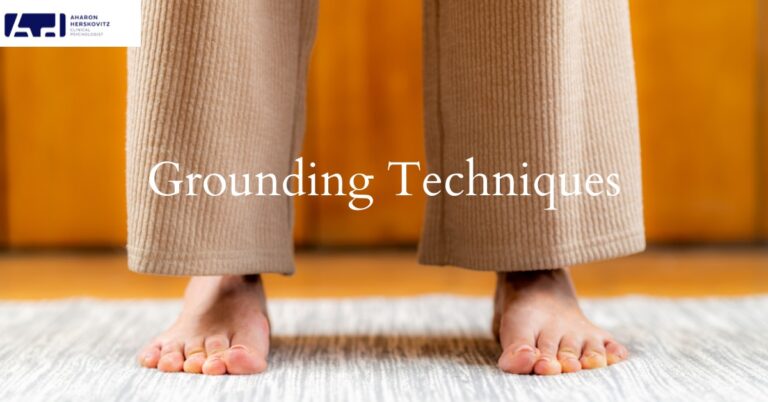Grounding Techniques to Overcome Being Overwhelmed
“You keep talking about ‘defusing’ from my thoughts, Aharon, which kind of shows me you’re disconnected from reality: when I’m freaking out, I’m not really able to start imagining leaves flowing down a stream! I’m losing it!” is something that my clients don’t say (they’re too polite), but the feeling is definitely there! (If you don’t know what defusion is, I’ve linked my previous article on the topic below.)
And indeed, there are points where our thoughts and feelings can be just so overwhelming that trying to do “higher-level” cognitive exercises is not going to help us. The pull of our thoughts or our racing heart create impediments that are simply too big to overcome in the moment.
For these situations, grounding techniques can be incredibly beneficial, as they help us connect to the present moment and reconnect to our bodies in a different way. To paraphrase *10 Things I Hate About You*, they can help us go from being overwhelmed to just plain whelmed. What these exercises have in common is that they engage our five senses, calm the nervous system, and create a sense of control.
When our mind has (either correctly or not) identified a situation as dangerous, it triggers a host of emotions, thoughts, and physiological symptoms, often referred to as the “fight or flight response.” When our minds and bodies are activated in this way, our psychological flexibility is severely limited. If we don’t do anything to stop this cycle, we might find ourselves unable to cope or engaging in actions that, in our untriggered state, we’d label as “irrational,” “unhelpful,” or “self-defeating.”
The goal of grounding exercises is to help us regulate our emotions, choose our focus, and grant us the freedom and flexibility to make mindful choices about our course of action. Often, grounding techniques can then be followed by the defusion techniques mentioned in my previous article (seriously, go check it out!).
Practical Grounding Techniques
Grounding techniques are best used in situations where you’re feeling overwhelmed. If you’re *starting* to feel like you’re getting to that stage, that’s also a wonderful time to use them! Just like most skills in life, grounding techniques take time to practice before you can fully benefit from them. Practicing these exercises during periods of relative calm will make them more effective during difficult moments.
Here are some practical grounding techniques to try:
1. 5-4-3-2-1 Technique
This classic grounding exercise engages your senses to bring you back to the present moment.
How to do it: Identify 5 things you can see, 4 things you can feel, 3 things you can hear, 2 things you can smell, and 1 thing you can taste.
Why it works: By focusing on your senses, you interrupt racing thoughts and bring your attention to the here and now.
2. Dropping Anchor
Inspired by Acceptance and Commitment Therapy (ACT), this technique helps ground you by reconnecting with your body and surroundings.
How to do it: Plant your feet firmly on the ground. Notice the sensation of the floor beneath you. Take slow, deep breaths, and look around to name specific objects you can see.
Why it works: It provides a moment of stability and reminds you that you’re safe in the present.
3. Box Breathing
This simple breathing exercise is often used by first responders to stay calm under pressure.
How to do it: Inhale for 4 seconds, hold your breath for 4 seconds, exhale for 4 seconds, and hold again for 4 seconds. Repeat the cycle.
Why it works: It slows your breathing and helps regulate your nervous system.
4. Physical Grounding
Using physical sensations can quickly bring you back to the present.
How to do it: Hold onto something textured, like a cold glass or soft fabric, and focus on the sensations. Or press your feet into the ground and notice how it feels.
Why it works: Physical grounding connects you to the immediate world around you, interrupting mental spirals.
5. Name What’s Around You
This technique combines observation with mindfulness.
How to do it: Choose a category (e.g., colors, shapes, or objects) and name items in that category as you see them around you.
Why it works: It shifts your focus outward, reducing the intensity of internal overwhelm.
Conclusion
Grounding techniques are powerful tools for managing moments of overwhelm. They’re not about solving the root of your distress but about giving you the space and clarity to take the next step. These techniques help regulate your emotions, shift your focus, and create the flexibility needed to make mindful choices—whether that’s returning to a challenging situation or transitioning to a calming activity.
Remember, grounding is a skill that improves with practice. Try these techniques during calmer moments so they’re ready when you need them most. And once you’ve grounded yourself, consider using defusion techniques to further reduce the power of intrusive thoughts. Together, these tools can help you navigate life’s challenges with greater ease and resilience.
